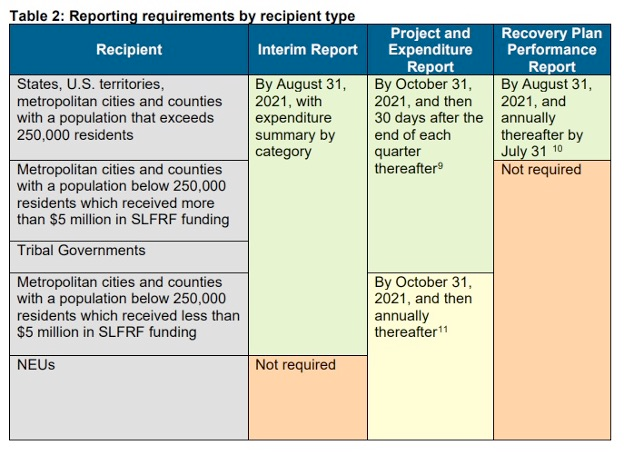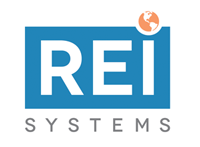|
The Treasury’s Guidance for State and Local Fiscal Recovery Funds (SLFRF)
By Adam Roth on June 29, 2021
The Treasury released the Compliance and Reporting Guidance for State and Local Fiscal Recovery Funds (SLFRF) on June 17, 2021. The guidance was issued to provide additional detail and clarification around the reporting, subrecipient monitoring, or single audit requirements for SLFRF program funds. The guidance itself aims to fill in those gaps, provide resources, and provide quick links to the Treasury’s expectations for recipient compliance responsibilities, best practices in relation to those responsibilities, and reporting requirements for the SLFRF program.
This new guidance only applies to SLFRF funds under the American Rescue Plan Act (ARPA), and does not change or impact reporting and compliance requirements for the Coronavirus Relief Fund (CRF) established by the CARES Act. Some of the new guidance is built on the guidance for CRF program funding requirements, but there are some departures as well. Namely, there is a much greater emphasis on performance reporting requirements, and on pre-award risk assessment – even more so than the UGG requires.
Our aim at AmpliFund is to provide you with a brief overview of some of the key principals that you should be aware of concerning eligibility, reporting, and single audit requirements so you can start implementing best practices today.
Eligibility
As established earlier in the Interim Final Rule, your organization has a lot of flexibility in how you choose to allocate your awarded SLFRF funds, so long as the expenditures fall under these four (4) categories:
- To respond to the COVID-19 public health emergency or its negative economic impacts;
- To respond to workers performing essential work during the COVID-19 public health emergency by providing premium pay to such eligible workers of the recipient, or by providing grants to eligible employers that have eligible workers who performed essential work;
- For the provision of government services, to the extent of the reduction in revenue of such recipient due to the COVID–19 public health emergency, relative to revenues collected in the most recent full fiscal year of the recipient prior to the emergency;
- To make necessary investments in water, sewer, or broadband infrastructure.
The Interim Final Rule is also where you can find definitions and clarifications that can further help you establish if your expenditure is eligible. You can also refer to the Assistance Listing for the SLFRF listing on SAM.gov (formerly known as CFDA Number, 21.027) for more information.
As a recipient of a SLFRF award, you may use the funds to cover eligible costs incurred between March 3, 2021 and December 31, 2024, as long as the funds for those obligations are expended by December 31, 2026.
You will need to maintain procedures for obtaining information evidencing, including a valid SAM.gov registration, eligibility for your organization, your subrecipients, and potential contractors as well.
Implementing risk-based due diligence for eligibility determinations is a best practice to augment your organization’s existing practices. There is also a greater emphasis on pre-award risk assessment in the guidance than we have seen with other funds.
Reporting
All recipients of Federal funds must complete financial, performance, and compliance reporting as required and outlined in Part 2 of the SLFRF guidance. SLFRF awards are generally subject to the requirements in the Uniform Administrative Requirements, Cost Principles, and Audit Requirements for Federal Awards, 2 CFR Part 200 (UGG). The new guidance provides a general summary of compliance responsibilities, and all awardees are encouraged to also review the 2020 OMB Compliance Supplement Part 3. Compliance Requirements (issued August 18, 2020).
The guidance does not change the reporting or compliance requirements pertaining to the CRF. The reporting requirements for SLFRF where changes from CRF requirements have occurred include:
- Project, Expenditure, and Subaward Reporting: The data elements for the Project and Expenditure Report will largely mirror those used for CRF, with some minor exceptions noted in the guidance. The users’ guide describes how reporting for CRF funds will relate to reporting for the SLFRF program.
- Timing of Reports: CRF reports were due within 10 days of each calendar quarter. SLFRF quarterly reporting will be due 30 days from quarter end.
- Program and Performance Reporting: The CRF reporting did not include any program or performance reporting, which is now required for SLFRF funds.
There are now three (3) types of reporting requirements for SLFRF program funds: the Interim Report (Section A, page 13), the Project and Expenditure Report (Section B, page 15), and the Recovery Plan Performance Report (Section C, page 23). We have taken a deeper dive into these reporting types and have created a guide to the Reporting Requirements for the Treasury’s SLFRF.
The following table describes new reporting requirements by recipient type:

|
|
Expenditures may be reported on a cash or accrual basis, as long as the methodology is disclosed and consistently applied. Reporting practices must be consistent with the definition of expenditures found in 2 CFR 200.1. Your organization should also implement controls to ensure timely adherence to all reporting requirements for your subrecipients as well.
Subrecipient Monitoring
SLFRF recipients that are pass-through entities as defined under 2 CFR 200.1 are required to manage and monitor their subrecipients to ensure compliance with requirements of the SLFRF award pursuant to 2 CFR 200.332 regarding requirements for pass-through entities. First, your organization must clearly identify to the subrecipient:
- That the award is a subaward of SLFRF funds;
- Any and all compliance requirements for use of SLFRF funds;
- Any and all reporting requirements for expenditures of SLFRF funds.
Your organization will need to perform a risk assessment to evaluate each subrecipient’s risk of noncompliance. These risk assessments may include factors such as prior experience in managing Federal funds, previous audits, personnel, and policies or procedures for award performance monitoring.
The Office of Management and Budget’s (OMB) Uniform Grant Guidance (UGG) demands standard ways of tracking and monitoring subrecipients, including:
- Providing clear performance goals, indicators, and milestones for your subrecipients based on OMB-approved standard information collection methods;
- Reviewing their financial and performance reports;
- Following up as necessary to ensure that recipients take appropriate action.
We have created a guide for local governments to help reduce the administrative burden associated with subrecipient monitoring progress to help you and your subrecipients maintain compliance.
Single Audit Requirements
Recipients and subrecipients that expend more than $750,000 in Federal awards during their fiscal year will still be subject to an audit under the Single Audit Act and 2 CFR Part 200, Subpart F.
For-profit entities that receive SLFRF subawards are not subject to Single Audit requirements. However, they are subject to other audits as deemed necessary by authorized governmental entities, including Treasury, the GAO, the PRAC and the Treasury’s OIG.
Recipients and subrecipients can refer to the Office of Management and Budget (OMB) Compliance Supplements for audits of federal funds for more information, and the Federal Audit Clearinghouse to see examples and single audit submissions.
*Seal image from U.S. Department of the Treasury
|





